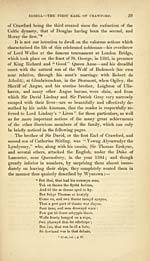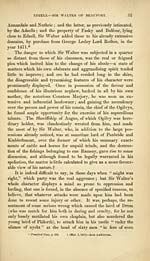Download files
Complete book:
Individual page:
Thumbnail gallery: Grid view | List view

30 , LAND OF THE LINDSAYS.
The cabil rape he strak in twa,
And gert them til the grownd than ga.
And qwhen the flud wes out, men fand
Bathe men and armowris wndyr sand
And thai, that than ethchapyd war,
Til thare schippis made thaim to fare,
And pressyd noucht mare for to tak land,
Qwhil that the Duk wes there bydand."*
Sir Alexander was designed from the lands of Kinneff, in
the Mearns ; and had, perhaps, resided in one or other of the
numerous strongholds of which that interesting and romantic,
but dangerous and inhospitable coast, could at one time boast.
Along with his brother, the future Earl, he also swelled the
camp of " the lichtsome Lindsays," who joined the banner of their
chief, Sir James, at the famous engagement of Otterburn, against
the combined forces of the Percies and the Mowbrays; and,
although their chief unwarily fell into -the hands of the enemy,
and was held prisoner for a time, Sir David of Glenesk, and his
brother, returned in safety, and the latter, many years after-
wards, fell at the luckless battle of Yerneuil.
Prior to his death in 1407, the first Earl gave the lands or
thanedom of Neudos, together with an annual pension of forty
marks out of the customs of the burgh of Montrose, to his second
son David, who also held the baronies of the Aird and Strathnairn,
in Inverness-shire, which, at a later period, were possessed by
Sir Walter, younger brother of Earl Beardie. Beyond all others
of his clan, Sir Walter was perhaps the most avaricious, and, at
the same time, lacked nothing of the tyranny and oppression which
characterised some of his more notorious relatives. Having had
the sole management of his nephew, Earl David, from boyhood,
he succeeded in consummating his long cherished desire of
changing his residence in Inverness for one in his native county,
by excambing his northern estates with the Earl, for the barony
of Feme, to which were afterwards added, first the mill and lands
of Invereskandye,t and next the lands of Edzell and Knocknoy,J
the former of which were possessed by vassals of the names of
• Wyntotvn's Cron., vol. ii, p. 320-21.
t Dye (Brit.) is said to be the old name of the West Water, and is synon. with the Gael.
dubh, " black ;" but De (Brit.) which denotes " rapidity of motion," is perhaps more descriptive
of this river — hence, from these lands lying at the mouth or confluence of the rivers North Esh
and Dye, they are named Inver-esk-an-dye.
t (a.d. 1460-1167)— Crawford Case, pp. 119-50, <tc.
The cabil rape he strak in twa,
And gert them til the grownd than ga.
And qwhen the flud wes out, men fand
Bathe men and armowris wndyr sand
And thai, that than ethchapyd war,
Til thare schippis made thaim to fare,
And pressyd noucht mare for to tak land,
Qwhil that the Duk wes there bydand."*
Sir Alexander was designed from the lands of Kinneff, in
the Mearns ; and had, perhaps, resided in one or other of the
numerous strongholds of which that interesting and romantic,
but dangerous and inhospitable coast, could at one time boast.
Along with his brother, the future Earl, he also swelled the
camp of " the lichtsome Lindsays," who joined the banner of their
chief, Sir James, at the famous engagement of Otterburn, against
the combined forces of the Percies and the Mowbrays; and,
although their chief unwarily fell into -the hands of the enemy,
and was held prisoner for a time, Sir David of Glenesk, and his
brother, returned in safety, and the latter, many years after-
wards, fell at the luckless battle of Yerneuil.
Prior to his death in 1407, the first Earl gave the lands or
thanedom of Neudos, together with an annual pension of forty
marks out of the customs of the burgh of Montrose, to his second
son David, who also held the baronies of the Aird and Strathnairn,
in Inverness-shire, which, at a later period, were possessed by
Sir Walter, younger brother of Earl Beardie. Beyond all others
of his clan, Sir Walter was perhaps the most avaricious, and, at
the same time, lacked nothing of the tyranny and oppression which
characterised some of his more notorious relatives. Having had
the sole management of his nephew, Earl David, from boyhood,
he succeeded in consummating his long cherished desire of
changing his residence in Inverness for one in his native county,
by excambing his northern estates with the Earl, for the barony
of Feme, to which were afterwards added, first the mill and lands
of Invereskandye,t and next the lands of Edzell and Knocknoy,J
the former of which were possessed by vassals of the names of
• Wyntotvn's Cron., vol. ii, p. 320-21.
t Dye (Brit.) is said to be the old name of the West Water, and is synon. with the Gael.
dubh, " black ;" but De (Brit.) which denotes " rapidity of motion," is perhaps more descriptive
of this river — hence, from these lands lying at the mouth or confluence of the rivers North Esh
and Dye, they are named Inver-esk-an-dye.
t (a.d. 1460-1167)— Crawford Case, pp. 119-50, <tc.
Set display mode to:
![]() Universal Viewer |
Universal Viewer | ![]() Mirador |
Large image | Transcription
Mirador |
Large image | Transcription
Images and transcriptions on this page, including medium image downloads, may be used under the Creative Commons Attribution 4.0 International Licence unless otherwise stated. ![]()
| Histories of Scottish families > History and traditions of the land of the Lindsays in Angus and Mearns > (48) Page 30 |
|---|
| Permanent URL | https://digital.nls.uk/94869602 |
|---|
| Description | A selection of almost 400 printed items relating to the history of Scottish families, mostly dating from the 19th and early 20th centuries. Includes memoirs, genealogies and clan histories, with a few produced by emigrant families. The earliest family history goes back to AD 916. |
|---|

